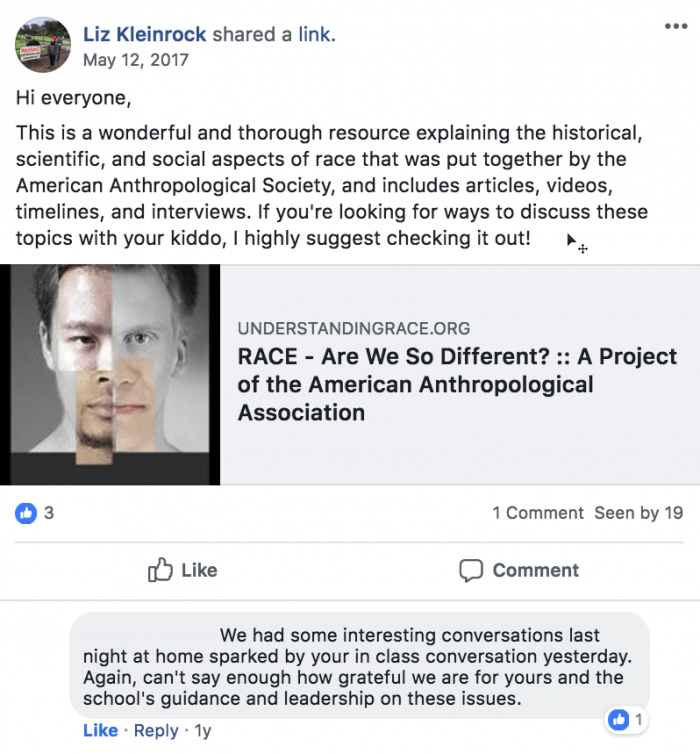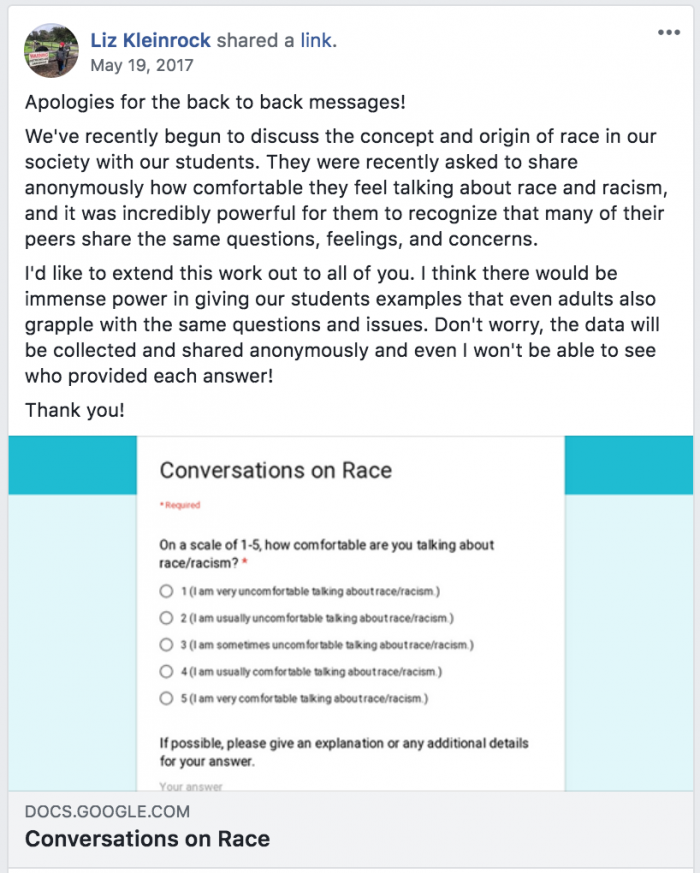In this interview, TT Award Winner Liz Kleinrock talks about the steps she takes at the beginning of the school year to connect with parents and family members and encourage them to become learning partners with her and her students.
What are some of the key aspects of your approach to family engagement?
I think that it needs to be a partnership. It’s really important for families to know that the teacher is on your side … [and] for families to know right off the bat that we’re working together to achieve the same goals and just support students.
I think that it’s important for teachers to also know what kind of experiences and baggage parents and family members might be coming into the conversation with. …[T]he way that families might have engaged or been excluded when they were in school can really impact how they view you as an educator.
I like to … ask family members about their experiences when they were in school. I like to give out a survey at the very beginning of the year that talks about, “What’s your preferred method of communication?” “What does access to technology look like in your home?” “Your preferred language?” “Would you feel more comfortable if there’s a translator present during our meetings?” Things like that.
But a big question that actually gives me the most information is asking parents, “What are your memories and experiences of fourth grade?” Some of these parents would write an essay about their teacher and either how much they loved their teacher or how awful that experience had been and how they felt very invisible and they didn’t have a voice. And that gives me a lot of background information about how they might be approaching me or the lens through which they might view me and the way that I communicate with them.
You mentioned doing family surveys at the beginning of the year. What are some other elements of that survey?
I like to ask families about what does a student’s routine look like when they’re not in school, starting from when they wake up in the morning to when they get dropped off at school to when they get picked up. And the rest of the evening too. I want to know what kind of extracurriculars students are involved in, hobbies. Is their schedule very heavily managed outside of school?
What are some of the most important things you’ve learned from these surveys?
I’ve learned a lot about parents’ concerns for their kids. There is so much trust that needs to be put into place when working with students. … You might not get a lot of face time, so how do you build that relationship with them when you’re not actually in the same place very often?
I try to share as much of my life with my students as what I expect or hope for them to be able to share with me. And I think that also goes into families, like when we might have meet-and-greets in October— asking them, “Where did you grow up? What are your interests?” Trying to feel out who they are as people.
Something that I try to put into place is, within the first two days of school, I will send out either a positive note or an email to every single family member in my class. Could be something as small as, “I got to eat lunch with your daughter today and she shared x, y and z about her life, and it was just so nice getting that face time with her.” Or, “I noticed that your son worked really well during this community building activity, and he shared these things with the class.” Just so families know right off the bat that you’re there to share the positives, the joys and the successes, not just, “Your kid had a behavioral issue today, and now we need to have a conversation about it.” That you’re there to share the good as well as ways to support their kid throughout the year.
How has your family engagement work made you a more effective teacher?
I think it’s made me a much more proactive teacher. If I can give families a heads up about what we’re learning and how they can support their student at home, then it’s very clear that this learning experience isn’t just confined to the classroom and that my families are also able to learn along with their students, which is really nice.
I think it has really helped me to see and practice how families are such an asset and they’re such important funds of knowledge that we need to continue to bring into the classroom—and emphasis on things like oral history and parents’ experiences with certain subjects or topics based on where and how they have lived. These are all ways that we can continue to pull them as resources into the classroom.
How do you handle communication with families about issues that might be controversial?
I’m very wary of asking permission to talk about issues that are deemed controversial. When you’re talking about issues surrounding race or LGBTQ topics, if you ask permission, there’s kind of an implication that there’s something wrong with talking about those topics, and that’s definitely not what I want to be getting at in my classroom.
For example, around the walkout this year, after the shooting in Parkland … you [heard] mostly stories of middle schoolers and high schoolers who are leading these protests. But the kids in elementary school, they still hear about it. They still want to be included because they’re still students that are impacted by these events that are happening in our country.
So what I would do is write up an email or a letter that goes home to families and say, “Hey, these are the options of what we are offering to our students. They can either choose to opt in, they can choose to opt out. It’s really up to them. But this is what you and your student can both expect on this day.”
And then after the walkout took place, I wrote up a summary of everything that happened. I wrote up bullet points of what students shared and how they were thinking and how they were feeling. And then I gave a couple guiding questions as well as resource articles to share with families so they can continue that dialogue at home.
When I do other topics, I keep a parent Facebook group that’s closed to my class. At first equity was a concern for me—like, if families don’t have smartphones, if they don’t have social media. But what I’ve learned is that everyone has some sort of social media and that many of the families are actually way more likely to respond and engage rather than like reading paper fliers that go home.
If we’re doing a topic around discrimination or stereotyping, then what I’ll most often do is actually take photos of student work that they produced during the day, and then I’ll post it at the end of the school day so families can also see what their kids are sharing in class. I want to be very upfront about what I’m doing, and that also, I think, builds a lot of trust between me and these family members as well.
What advice do you have for teachers who might want to prioritize family engagement this school year but aren’t quite sure where to begin?
I think you can always start by asking family members how they want to engage. Do they want to engage by volunteering in the classroom? By being guest speakers for community events? What’s going to work for them? You always have to be able to accommodate and balance people’s working schedules, whether they have time or not, and showing that there are lots of different ways to participate. But asking—first and foremost—and also creating ways to get to know family members on a very personal level, the same way that you would want them to know you.
I am an educator, but there’s a lot more to me than just that. And these people are parents and family members, but there’s a lot more to them than just those labels and titles as well.
van der Valk is the deputy director of Teaching Tolerance.




0 COMMENTS